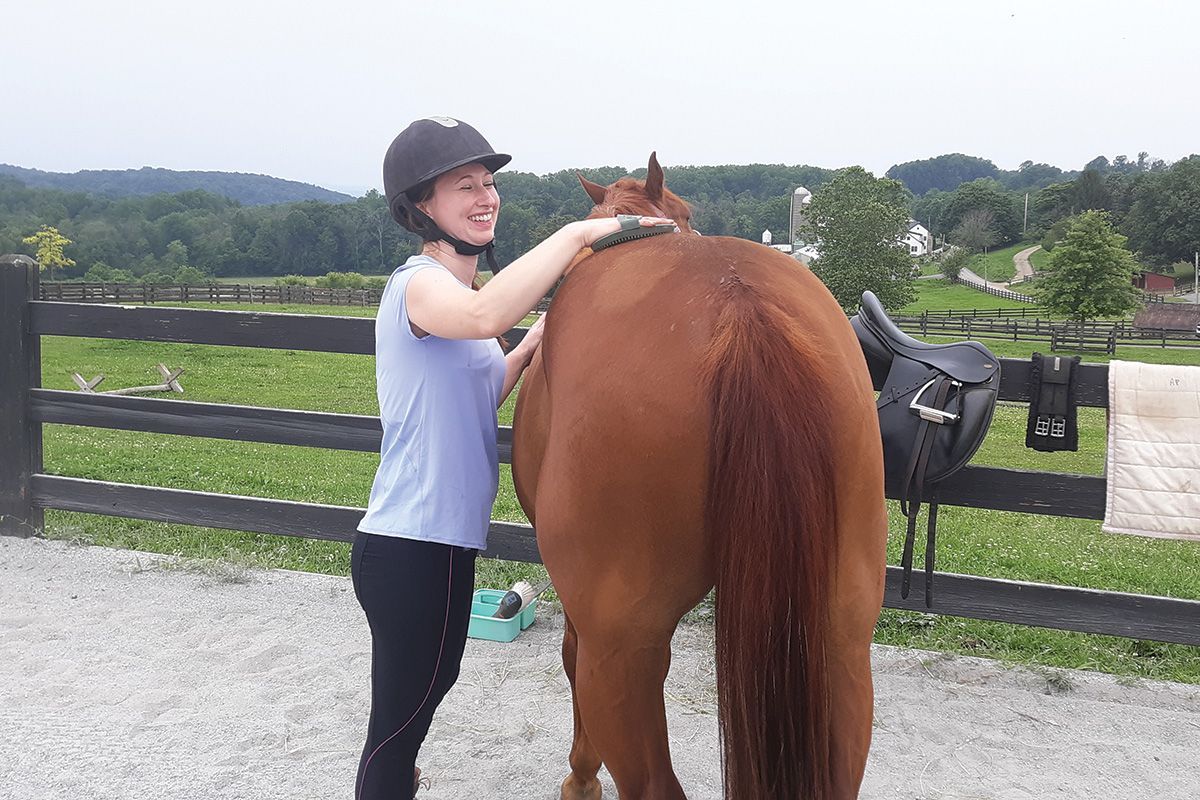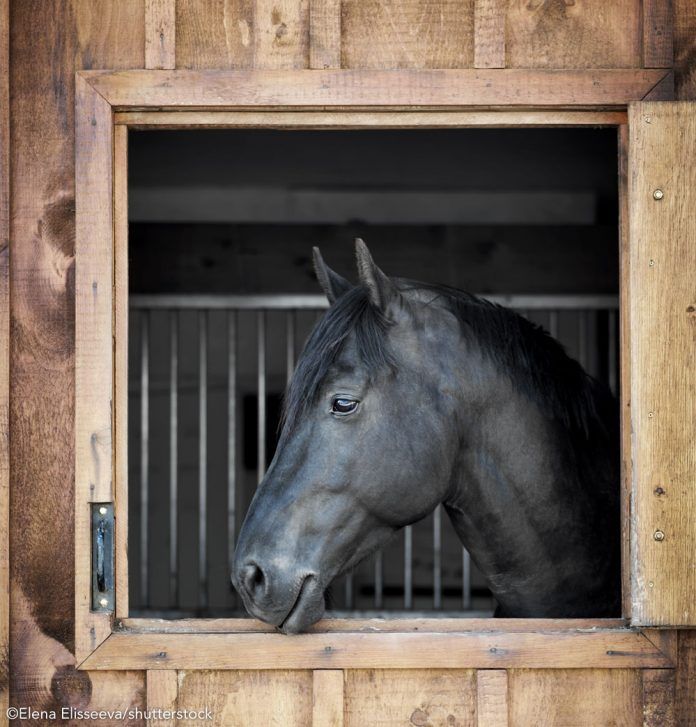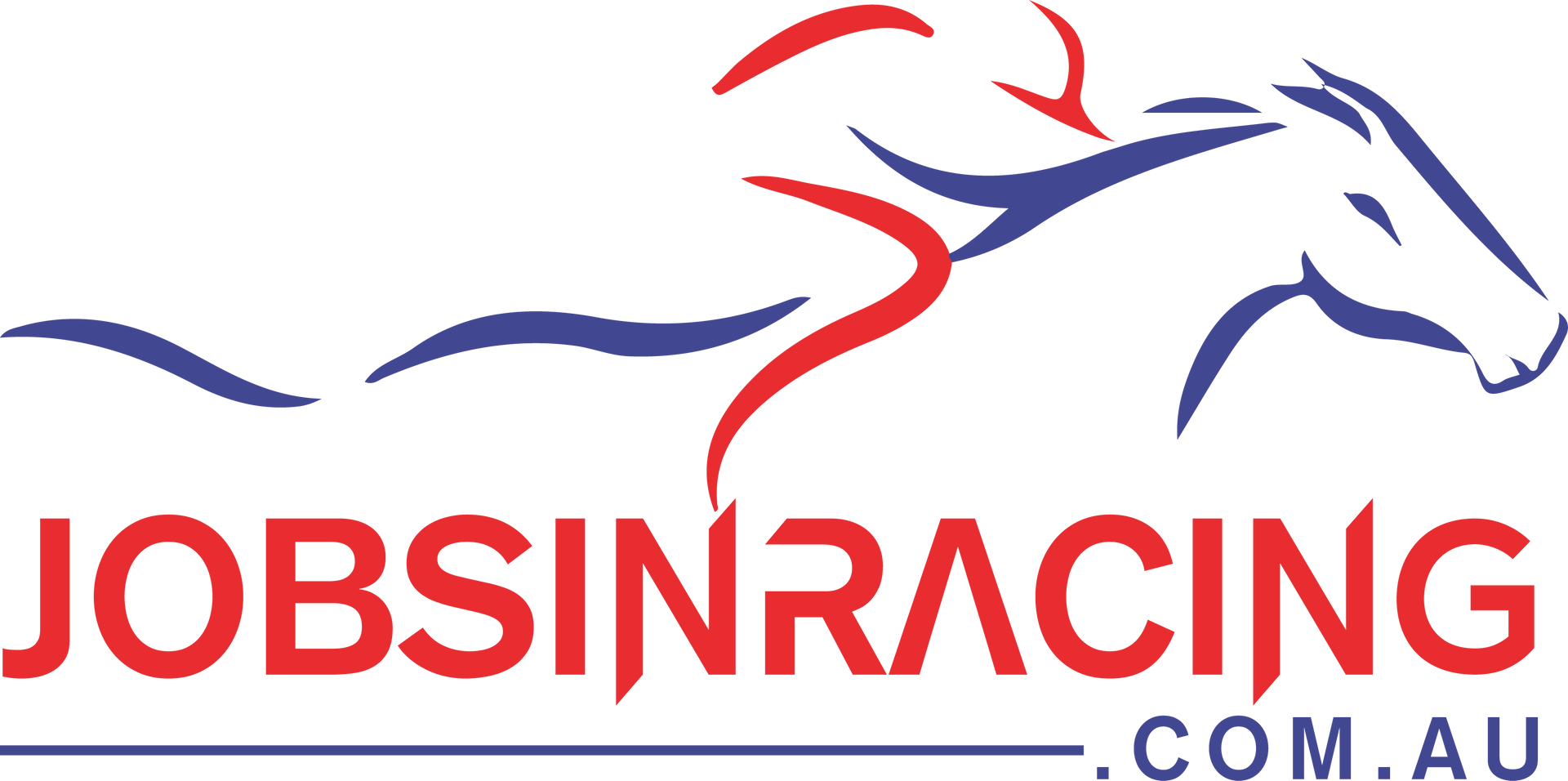10 Horse Grooming Hacks
Keep your horse’s coat healthy and happy year-round with these 10 horse grooming tips and hacks from two professional grooms.
When you list what’s in your grooming box, have you ever mentioned a hair dryer, laundry detergent, or dryer sheets alongside your favorite brushes?Drawing on our personal experiences as grooms for show jumping Olympic medalists Anne Kursinski and Kent Farrington, Lindsey Trockenbrot and I compiled this list of grooming hacks. While they may seem obscure, they will help you promote your horse’s coat health.
1. Hot Toweling
Hot toweling is a great way to clean your horse without the wash rack—especially in winter when the dust goes deep and the weather is too cold for a bath. All you need is a bucket of hot water, two towels, and a bottle of your favorite coat conditioner or coconut oil.
Soak the first towel completely and wring it out well. Rub the rag over the horse’s body like you would with a curry comb, going gently against their coat to get beneath the hair.
Once you’ve gone over your horse once, soak and wring out your second towel. This time, spray your coat conditioner of choice directly on the towel. Now go over the horse again, spraying additional conditioner on the towel as needed. Be mindful that you are not applying coat conditioner to the saddle and girth areas if you’re planning to ride that day.
To bring out that extra shine after hot toweling, go over your horse with a hard brush, followed by a soft brush.
2. Hair Dryer
When the weather is too cool for a bath, taking a hair dryer to your horse’s woolly winter coat (desensitizing him first, of course) will dry out his sweat marks in no time. Any household hair dryer will do the trick for this hack.
Once the hair is dry, just curry and brush it out. There’s no need to wait hours for your horse to dry when you can hair dry him!
3. Waterproof Ointment
If your horse has soft hooves, you live in an area where the humidity is high, or your horse gets frequent baths and/or his legs washed, this hack is for you.
To help prevent your horse’s hooves from absorbing water while being rinsed or bathed, apply Corona ointment or Vaseline to the walls of his hooves before you bathe him. This seals the hooves so the water will bead right off of them.
4. Dryer Sheets
When the air is particularly dry, does your horse’s staticky hair—and tail in particular—drive you crazy? Try taking a dryer sheet and rubbing it all over his mane, tail, and body. This will help lessen the static in no time—and it also helps keep bugs away!
5. Apple Cider Vinegar
When the sun and bugs are out in the heat of the summer, rinsing your horse in apple cider vinegar will become one of your favorite tricks in the barn. Apple cider vinegar is one of the most beneficial ways to help cool a horse down and keep the bugs away.
Add enough ACV to cover the bottom of a bucket, then fill the bucket with water. Use a sponge or rag to generously douse your horse in the mixture. Don’t worry about rinsing him off—just sweat scrape and you’re done.
While your horse may smell a bit like a salad, he will thank you for helping them keep the bugs away and helping him cool off!
6. Laundry Detergent
If you’ve tried every product under the sun to rid your horse’s white tail of stains or are trying to brighten white legs, try using detergent. Yes, as in the one you use to wash your laundry!
Dilute the laundry detergent just as you would with regular shampoo (just a glug in a full bucket of water), scrub, rinse, and voila, your horse will be blindingly white.
7. Mouthwash
Have you seen your horse rubbing his rear on his stall, feeder, or water buckets? Mouthwash might be the solution you are looking for.
Dilute Listerine mouthwash 1 part mouthwash to 4 parts water in a spray bottle. Spray liberally and work into the roots of your horse’s mane or tail.
You can spray this solution daily or as needed. This hack should not replace washing your horse’s tail, but is a helpful addition to your grooming routine.
8. Socks
Putting socks on your horse while riding him in sand arenas, alongside currying and keeping his legs clipped below the fetlock, may help minimize fungus on the back of his pasterns.
There are socks specifically made for horses, but a pair of human crew socks will also do the trick. Simply cut the foot of the sock off, leaving the tall part intact, and pull the sock over your horse’s hoof so that it covers their pastern and fetlock.
Tip: Try putting a gallon-sized Ziploc bag over your horse’s hoof to make putting the sock on easier.
To help keep the sock in place while riding, use a pair of hind boots. Socks are also a great way to keep your horse’s white legs clean overnight at a horse show.
9. Vacuuming
Not to be mistaken for a household vacuum, this vacuum is designed for horses. While these units will cost you a pretty penny, you’ll find them to be worth every cent.
Vacuums allow you to get your horse looking his best without the hassle of a bath. From cleaning sand, dust, and even feathers, vacuums have a tremendous impact on your horse’s coat health. They are particularly useful for removing sand and dust, which will help keep fungus from developing on your horse in humid climates.
For optimal results, curry your horse thoroughly beforehand to loosen the dirt on their coat. Be sure to desensitize your horse before vacuuming.
10. Olive, Coconut, and Baby Oil
While nearly everyone has a bottle of olive oil in their pantry, not many equestrians have olive oil stashed in their tack box. One of the biggest benefits of olive oil is that it can help keep your horse’s hooves conditioned. Simply applying it to your horse’s hooves with a brush or rag will help condition the hoof wall and procure a polish-like shine.
Next time you’re looking to add shine to your horse’s coat at a show or at home, try combining coconut oil with water in a small bucket or a spray bottle. While being mindful of areas where your tack will sit, spray or use a damp towel to apply the coconut oil to the horse’s coat. After applying the oil, use a soft brush to go over your horse’s coat and enhance the shine.
Additionally, baby oil or witch hazel can be used to soothe recently clipped areas on horses, especially around more sensitive areas, such as the muzzle, face and legs. Wipe your horse down with a damp rag and oil, focusing on these sensitive areas.
While these hacks will never replace the benefits of traditional grooming, they are excellent additions to your horse’s grooming routine that will help promote a happy and healthy coat.
Source: https://www.horseillustrated.com/10-horse-grooming-hacks


